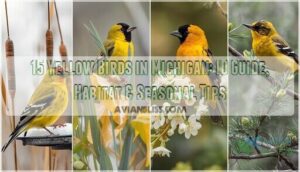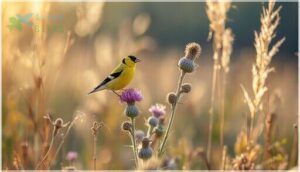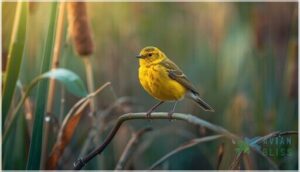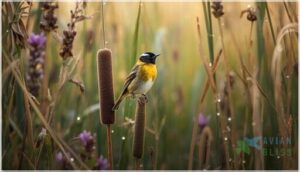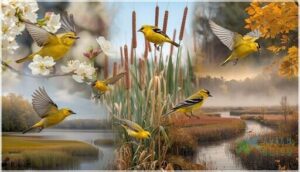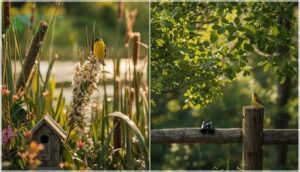This site is supported by our readers. We may earn a commission, at no cost to you, if you purchase through links.
A flash of bright yellow catches your eye at the backyard feeder, and suddenly you’re hooked. Michigan hosts over a dozen yellow bird species throughout the year, from the cheerful American Goldfinch that sticks around through winter to rare migrants like the Kirtland’s Warbler that nest nowhere else on earth.
Some arrive with spring’s first warmth, others pass through during fall migration, and a few brave the snow alongside you. Knowing when and where to look makes all the difference between a lucky sighting and consistent observations.
The trick is matching field marks to habitat and season—that black mask might be a Common Yellowthroat in the marsh, while vivid orange-yellow flashes in the treetops signal a Baltimore Oriole claiming territory.
Table Of Contents
- Key Takeaways
- Most Common Yellow Birds in Michigan
- Migratory and Seasonal Yellow Species
- Rare and Notable Yellow Birds
- Identifying Yellow Birds in Michigan
- Habitats and Conservation of Yellow Birds
- Frequently Asked Questions (FAQs)
- What bird is yellow in Michigan?
- Do goldfinches stay in Michigan all year?
- What is the most common yellow bird?
- What color is a Yellow Warbler?
- Are there yellow warblers in Michigan?
- Are yellow birds common in Michigan?
- What does a yellow bird look like in summer?
- What Michigan birds are yellow?
- What color is a yellow warbler?
- What kind of bird in Michigan is yellow?
- Conclusion
Key Takeaways
- Michigan hosts over a dozen yellow bird species with varying seasonal patterns—American Goldfinches stick around year-round while species like Yellow Warblers and Baltimore Orioles arrive only during breeding season from late April through summer.
- Successful identification depends on matching specific field marks to habitat and timing, such as the Common Yellowthroat’s black mask in marshes versus the Baltimore Oriole’s orange-yellow flashes in deciduous treetops.
- The Kirtland’s Warbler stands out as Michigan’s rarest yellow bird, nesting almost exclusively in the state’s jack pine forests and recovering to roughly 2,400 individuals thanks to targeted habitat restoration and prescribed burns.
- Conservation efforts have produced measurable results across species, with wetland restoration boosting Yellow Warbler territory densities by 15-35% and native plantings in urban yards increasing bird encounters by 12%.
Most Common Yellow Birds in Michigan
If you’re spotting yellow birds around Michigan, chances are you’re seeing one of the usual suspects.
These five species show up most often across the state, whether you’re watching your backyard feeder or walking through a local park.
Let’s take a look at the birds you’re most likely to encounter on any given day.
American Goldfinch
You’ll spot the American Goldfinch year-round in Michigan—a true backyard favorite among yellow birds. Males flash bright yellow plumage with black caps and wings during breeding season, while their diet focuses on sunflower and thistle seeds. These finches prefer open fields and hedgerows for nesting, and you can attract them easily with nyjer-filled feeders. Their bouncy flight and twittering calls make goldfinch identification straightforward across Michigan’s diverse bird species.
Understanding research network concepts can help in identifying key species and their habitats.
Yellow Warbler
Shift your gaze from finches to warblers, and you’ll find the Yellow Warbler—one of Michigan’s brightest migratory treasures. This small songbird arrives in late April, sporting vivid yellow feathers with subtle rusty streaks on the breast. Listen for its distinctive “sweet-sweet-sugar” song during Michigan birding trips.
Here’s what sets this warbler species apart:
- Diet: Insects, caterpillars, and spiders fuel breeding adults
- Nesting habits: Cup-shaped nests in shrubs near streams
- Migration: Departs by September for Central America.
Understanding the theme development process is essential for effective communication about bird species.
Common Yellowthroat
Another warbler you’ll often encounter is the Common Yellowthroat, easily recognized by its striking black mask. This species thrives in dense vegetation—thickets, wetlands, and brambles where it hunts insects and caterpillars.
Listen for its distinctive “witchity-witchity-witchity” call during breeding season. You’ll find nests tucked low in grasses near water, where feeding patterns shift with seasonal insect availability throughout Michigan’s warmer months.
Eastern Meadowlark
Out in Michigan’s open grasslands, you’ll spot the Eastern Meadowlark with its bright yellow belly and bold black V-shaped throat patch. This robin-sized bird measures around 7.5–9 inches and delivers flute-like melodies from fence posts during the spring breeding season.
Watch for its distinctive feather patterns as it forages on the ground, often appearing across southern Michigan’s agricultural edges and meadows.
Baltimore Oriole
Come late April, you’ll catch the Baltimore Oriole’s flash of orange-ochre against black wings as males arrive in Michigan’s deciduous forests. These medium-sized songbirds favor edge habitats near water for nesting sites, where they defend territories with clear, whistling songs.
Watch for breeding habits through summer before they depart by October. Females show paler, olive-toned plumage changes compared to vibrant males.
Migratory and Seasonal Yellow Species
Not all yellow birds stick around Michigan year-round. Some show up only during migration or hang out for specific seasons before heading south.
Here’s a look at five migratory and seasonal species you’ll want to watch for at the right time of year.
Yellow-Rumped Warbler
If you’re scouting yellow bird species in Michigan during migration, the Yellow-Rumped Warbler is your reliable fall companion. You’ll spot adults with bright yellow throat patches and rumps in mixed forests from late August through early October.
- Peak spring migration: Late April to mid-May along lakefront hotspots
- Breeding habitat: Coniferous stands across northern Michigan forests
- Food sources: Insects and fruit from understory shrubs
Listen for their buzzy trill echoing from treetops at dawn—it’s your best identification clue during busy migration windows.
Palm Warbler
You’ll catch Palm Warblers passing through Michigan in late April, wagging their tails while foraging along forest edges. These compact warblers show yellow bellies with olive backs and a pale eye-stripe—migration patterns bring them through coastal wetlands and scrubby young forests.
Watch for their ground-foraging behavior near bogs. Plumage variation appears between spring and fall, with breeding habits occurring farther north in boreal regions.
Cedar Waxwing
You’ll spot Cedar Waxwings in Michigan during late summer and fall, drawn by abundant fruit foraging opportunities on serviceberries and dogwood. These sleek birds show pale yellow belly washes with distinctive red wing-tip drops—their winter behavior depends heavily on berry availability.
Watch for their buzzy calls and undulating flight patterns as flocks move through riparian corridors, with nesting habits usually occurring in northern forests during breeding season.
Scarlet Tanager
You’ll find male Scarlet Tanagers glowing like embers in Michigan’s deciduous forests from late May through early October during breeding season. Males flash vivid scarlet bodies with jet-black wings, while females wear olive-yellow tones that complicate warbler identification.
They forage high in dense canopies, eating insects and fruit like berries. Bird migration brings them through northern hardwood forests, where breeding patterns show stronger concentrations in lake-effect stands.
Pine Warbler
You’ll recognize Pine Warblers by their soft yellow wash and faint breast streaking—pale compared to other Michigan warblers.
They nest in northern pine forests from late May through early July, then migrate south between late August and September. Listen for their chatty trill from treetops during spring migration routes.
Pine Warbler habitat centers on conifer stands where breeding patterns show stable populations in mixed pine forests.
Rare and Notable Yellow Birds
Not every yellow bird you’ll see in Michigan is a backyard regular. Some species are so rare or specialized that spotting one feels like striking gold.
Let’s look at five yellow birds that stand out for their scarcity, unique habitats, or conservation stories.
Kirtland’s Warbler
Michigan’s rarest gem, the Kirtland’s Warbler, nests almost exclusively in jack pine forests here. You’ll need to know what makes this endangered beauty stand out:
Michigan’s rarest gem, the Kirtland’s Warbler, nests almost exclusively in the state’s jack pine forests
- Bluish-gray back with bright yellow underparts and black streaking along sides
- Ground-nesting habits in young jack pine stands maintained through prescribed burns
- Males deliver a loud, low-pitched song from treetops during breeding season
- Population trends show recovery to roughly 2,400 individuals thanks to habitat restoration
- Migration patterns take them to Bahamas for winter months
Conservation status depends entirely on fire-managed landscapes.
Hooded Warbler
Hooded Warblers are even scarcer in Michigan than Kirtland’s. You’ll spot males by their striking black hood framing bright yellow faces—females show a subtler version.
Listen for their scratchy “teacher, teacher, teacher” song in dense understory near southern streams. Breeding records average fewer than five per year, mostly in the Upper Peninsula’s mature deciduous forests.
Migration peaks mid-May, with fall passage brief through river corridors.
Prothonotary Warbler
Prothonotary Warblers bring golden-orange brilliance to Michigan’s wooded swamps, though habitat loss has trimmed their numbers by 20-40% in parts of the state over the past decade.
You’ll find them nesting in tree cavities near southern wetlands, arriving late April through early May. Their 50-60% nest success depends heavily on water levels and predation.
Wetland conservation efforts remain critical for this declining species.
Dickcissel
If you’re exploring grassland habitats, you might spot a Dickcissel—though sightings in Michigan remain rare. This yellow-throated seed-eater prefers tallgrass prairies and field edges, arriving mid-to-late May.
- Males show bold black bibs and bright yellow throats
- Fast, buzzing “che-whee” song aids Yellow Bird Identification
- Grassland Conservation efforts target habitat loss
- Breeding Patterns peak June through early August
Citizen science tracking helps monitor this declining species.
Yellow-Breasted Chat
A skulker in dense thickets, the Yellow-Breasted Chat is Michigan’s rarest yellow bird. You’ll find this warbler species hiding in brushy riparian zones and overgrown edges, mostly in southern counties during May through early summer.
Listen for its odd, buzzy Song Patterns—key to Yellow Bird Identification.
Habitat Loss threatens already-low numbers, making Conservation Status uncertain. Michigan birding records remain sporadic, reflecting fragmented Migration Routes and secretive Breeding Habits.
Identifying Yellow Birds in Michigan
Spotting a flash of yellow in the trees is exciting, but figuring out which bird you’re actually looking at can be tricky. Michigan’s yellow birds share some features, but they also have key differences that set them apart.
Here’s what to watch for when you’re trying to nail down an ID.
Plumage Patterns and Markings
When you’re spotting yellow birds in Michigan, feather coloration tells the whole story. The American Goldfinch shows off bright yellow with bold black wing bars, while the Yellow Warbler keeps it simple with canary-yellow all over. Look for the Yellowthroat’s black mask or the Yellowheaded Blackbird’s bright head.
Check beak shapes and tail feathers too—they’ll help you nail the ID every time.
Distinctive Songs and Calls
You can identify yellow birds by ear once you learn their signature sounds. The American Goldfinch delivers a tinkling, high-pitched chatter during flight, while the Yellow Warbler sings a sweet “sweet-sweet-sweet-sweet” trill. Listen for the Common Yellowthroat’s rhythmic “witchity-witch” call from brushy spots.
Audio identification through call recognition and song patterns makes bird vocalizations your best tool for warbler species ID.
Seasonal and Regional Presence
Timing is everything when you’re tracking yellow birds in Michigan. Yellow Warbler migration patterns bring these birds from late April to August, peaking in June across southern counties. American Goldfinches stick around year-round but show peak numbers in July.
Regional variations matter too—Kirtland’s Warblers nest exclusively near Thunder Bay, while Baltimore Orioles favor deciduous woodlands during seasonal shifts from late April through mid-June.
Size and Behavior Cues
Body size separates yellow bird species fast—American Goldfinch measures around 5 inches while warblers run smaller at 4–5 inches. Flight patterns matter too: Goldfinches bounce through the air in quick bursts, but warbler species fly direct and purposeful.
Plumage brightness tells you age—adults show richer yellow tones than young birds. Watch behavior traits like tail flicking and foraging height to nail your ID.
Habitats and Conservation of Yellow Birds
Understanding where Michigan’s yellow birds live—and what threatens them—helps you know where to look and how to support their survival.
These species occupy everything from deep forests to your own backyard, each with specific needs and challenges.
Let’s break down the habitats they prefer and the conservation work that’s keeping them around.
Forest and Grassland Preferences
Yellow birds choose their homes carefully. The American Goldfinch prefers deciduous woodlands with thistle patches, while the Yellow Warbler thrives along stream edges with dense shrubs—occupancy jumping 15-25% after wet springs. The Eastern Meadowlark favors tallgrass prairies, showing stable populations. The Baltimore Oriole seeks mature fruiting trees in shaded forests.
Habitat preservation and grassland management support these warblers and other bird species across Michigan’s diverse ecosystems.
Wetlands and Riparian Zones
Marshes and stream edges host some of Michigan’s most vibrant yellow species. Wetland ecology sustains Yellow Warblers and American Goldfinches in willow thickets, where habitat restoration has boosted avian habitat preservation. Riparian management improves water quality and ecosystem services for birdwatching in Michigan hotspots:
- Prothonotary Warblers occupy floodplain forests with seasonal inundation
- Common Yellowthroats thrive in emergent vegetation along streams
- Restored buffers increase warbler territory densities by 15-35%
- Groundwater discharge sustains baseflows, supporting riparian zones year-round
Backyard and Urban Environments
You can spot American Goldfinches at your feeders year-round, especially when you use native seed mixes—they boost sightings by about 22%.
Urban bird feeders and backyard habitats with birdbaths draw Yellow Warblers during migration, increasing city birding detections up to 25%.
Yard conservation matters: tree-lined streets and native plantings lift urban wildlife encounters by 12%, making birdwatching in Michigan cities surprisingly rewarding for habitat preservation efforts.
Conservation Efforts and Population Trends
Beyond feeders and backyards, conservation efforts shape Michigan’s yellow bird future. You’ll see measurable gains:
- Kirtland’s Warbler recovery: habitat restoration pushed breeding pairs from near-extinction to about 2,300 by 2022—a stunning comeback.
- American Goldfinch stability: population dynamics reflect seed-rich landscapes and ecological balance across the state.
- Yellow Warbler monitoring: species conservation tracks regional declines, guiding wildlife conservation and environmental sustainability initiatives statewide.
Frequently Asked Questions (FAQs)
What bird is yellow in Michigan?
Michigan hosts several bird species with yellow feathers, including the American Goldfinch, Yellow Warbler, Common Yellowthroat, and Baltimore Oriole.
These species vary in their plumage patterns, bird songs, and seasonal presence across different Michigan habitats.
Do goldfinches stay in Michigan all year?
Yes, American Goldfinches stay in Michigan year-round in most years. You’ll find them at backyard feeders through winter, especially in southern and central counties where seed-rich habitats sustain wintering flocks.
What is the most common yellow bird?
The American Goldfinch dominates Michigan’s yellow bird species count, reaching 3–4 individuals per hectare during breeding season.
You’ll spot this abundant finch’s bright yellow plumage and distinctive black cap throughout suitable habitats statewide.
What color is a Yellow Warbler?
You’ll spot bright yellow underparts and a greenish-yellow back. Males show richer plumage than females, with chestnut streaks on their chest—key for warbler identification during Michigan birdwatching.
Are there yellow warblers in Michigan?
You’ll find Yellow Warblers breeding across Michigan’s forests from mid-May through late August. During peak migration, surveys detect around 8–4 birds per hour in suitable riparian and woodland edge habitats statewide.
Are yellow birds common in Michigan?
You’ll regularly encounter yellow birds across Michigan, especially American Goldfinches year-round.
During migration peaks, species like Yellow-Rumped Warblers surge through, making yellow bird sightings quite common for dedicated bird watching enthusiasts.
What does a yellow bird look like in summer?
In summer, males wear vivid yellow feathers with bold color patterns. The American Goldfinch sports a black cap, while warblers and Yellow-breasted Chat show reddish breast streaks that help with bird identification.
What Michigan birds are yellow?
Michigan hosts over 20 types of yellow birds, including the American Goldfinch, Yellow Warbler, Common Yellowthroat, and Yellow-rumped Warbler. You’ll also see Baltimore Orioles, Eastern Meadowlarks, and the rare Yellow-breasted Chat.
What color is a yellow warbler?
The yellow warbler shows striking yellow plumage across its body.
Males display vibrant yellow underparts with subtle olive backs, while faint breast streaking helps with bird identification among warblers sharing similar feather colors.
What kind of bird in Michigan is yellow?
You’ll spot several yellow species here, including the American Goldfinch, Yellow Warbler, Common Yellowthroat, Eastern Meadowlark, Baltimore Oriole, and during bird migration, the Yellow-rumped Warbler and Palm Warbler passing through.
Conclusion
Ever notice how a single flash of yellow can turn an ordinary morning into something worth remembering? Michigan’s yellow birds offer that gift year-round if you know where to look.
From goldfinches at your feeder to warblers tucked in spring wetlands, each species rewards your attention with its own story.
Keep your binoculars handy, learn the songs, and watch the seasons unfold. The next yellow bird in Michigan might be closer than you think.

